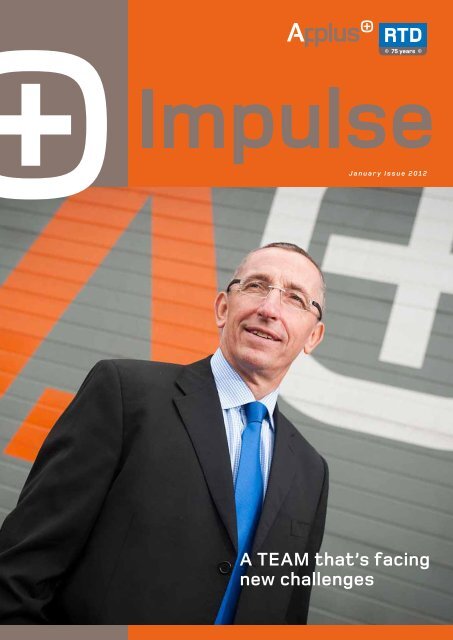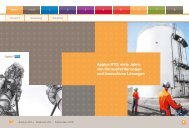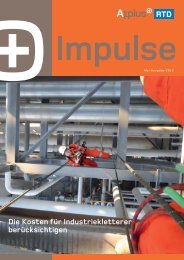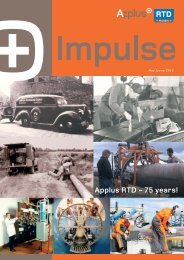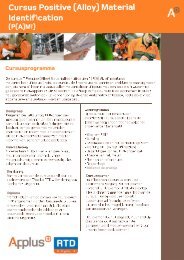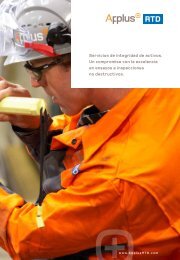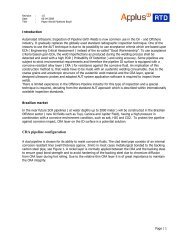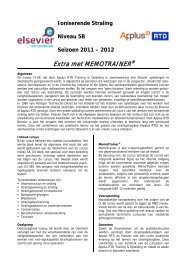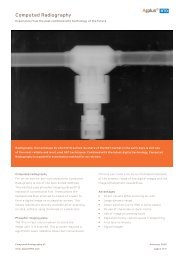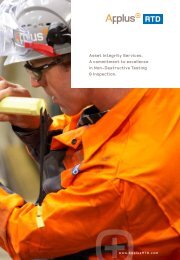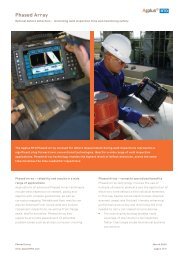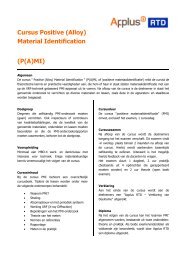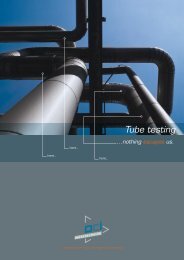A TEAM that's facing new challenges - Applus RTD
A TEAM that's facing new challenges - Applus RTD
A TEAM that's facing new challenges - Applus RTD
Create successful ePaper yourself
Turn your PDF publications into a flip-book with our unique Google optimized e-Paper software.
J a n u a r y I s s u e 2 0 1 2<br />
A <strong>TEAM</strong> that’s <strong>facing</strong><br />
<strong>new</strong> <strong>challenges</strong>
2<br />
C o l o p h o n<br />
Impulse is a publication of<br />
the <strong>Applus</strong> <strong>RTD</strong> Group<br />
With every edition of Impulse, it is our aim<br />
to both surprise and stimulate you. In this<br />
issue, we examine how solutions have been<br />
created, often working in close collaboration<br />
with our clients and major centers of<br />
learning. Solutions that meet inspection<br />
<strong>challenges</strong> that are often found in locations<br />
in, above, or below water, and that are often<br />
inhospitable and sometimes dangerous.<br />
Maybe you too have ‘a tale to tell’ and would<br />
like to share your experiences with our many<br />
global readers? If you do, just contact your<br />
local <strong>Applus</strong> <strong>RTD</strong> representative or the<br />
Impulse Editorial Team... we look forward to<br />
hearing from you.<br />
For further information on any of the<br />
articles, please contact the Editorial team.<br />
We will arrange for you to receive that<br />
information via the author of the article.<br />
Other questions, comments and<br />
suggestions should be sent to:<br />
Impulse Editorial Team<br />
<strong>Applus</strong> <strong>RTD</strong> Group<br />
P.O. Box 491<br />
2900AL Capelle aan de IJssel<br />
The Netherlands<br />
T +31 10 716 61 13<br />
F +31 10 716 63 73<br />
impulse@applusrtd.com<br />
www.<strong>Applus</strong><strong>RTD</strong>.com<br />
Anouska Kroon<br />
Group Journalist<br />
<strong>Applus</strong> <strong>RTD</strong> Group<br />
Care has been taken to ensure that all<br />
information contained in Impulse is correct<br />
and up-to-date. However, <strong>Applus</strong> <strong>RTD</strong><br />
accepts no liability for any inaccuracies<br />
or changes to published material.<br />
5<br />
7<br />
10<br />
12<br />
13<br />
14<br />
16<br />
17<br />
18<br />
C o n t e n t s<br />
ToFD inspection during<br />
EDF nuclear power plant shutdown<br />
First IWEX 3D Imager Portable Ultrasonic<br />
Imaging System<br />
Teamwork... the key to effective<br />
customized solutions<br />
News in Brief<br />
Award winners in Rio!<br />
New faces. Familiar faces.<br />
All with <strong>new</strong> <strong>challenges</strong><br />
A focus on safety<br />
Growth through acquisition<br />
ROTOSCAN... testing over 60 km of the<br />
Bunde–Etzel Pipeline<br />
1937 – 2012<br />
<strong>Applus</strong> <strong>RTD</strong>... celebrating 75 years<br />
of teamwork and commitment
I m p u l s e - J a n u a r y 2 0 1 2<br />
A <strong>TEAM</strong> that’s <strong>facing</strong><br />
<strong>new</strong> <strong>challenges</strong><br />
Since the last issue of Impulse, Iain Light has joined the organization in the capacity of<br />
<strong>Applus</strong> <strong>RTD</strong> CEO. He takes this opportunity to introduce himself while also providing a<br />
business and personal background to Impulse readers. At the same time he looks ahead<br />
to his aims and ambitions for the future.<br />
I am delighted to have joined <strong>Applus</strong> <strong>RTD</strong> in the position of CEO, located in the Capelle<br />
aan de IJssel office. This post became effective as of July 1st, and since then, whilst the<br />
timing might have been better (with many colleagues on holiday at that time), I have kept<br />
myself busy meeting people and learning about our company and the <strong>challenges</strong> that lie<br />
before it from colleagues all over the world.<br />
The history of <strong>Applus</strong> <strong>RTD</strong> (and before that <strong>RTD</strong>) is well known to me, having joined from<br />
Lloyd’s Register where I was Group Energy Director for 4 years. In that position I was<br />
well aware that at one point in the recent past, <strong>RTD</strong> was closely connected to that<br />
organization. Prior to being with Lloyd’s Register I spent nearly 15 years with DNV where I<br />
held a number of roles – my last position being COO of DNV Consulting. Before that I was<br />
that I was responsible for all of DNV’s Oil and Gas business on a global scale. I spent nearly<br />
7 of those years living in Norway.<br />
On the personal front, this year I will have been married to my wife Jane for 32 years. We<br />
have 3 children. The eldest son is a surgeon based in Newcastle, England, my daughter is a<br />
trainee lawyer in Aberdeen, Scotland and my youngest son is relocating to Perth, Western<br />
Australia to take up a post of field geologist with a mining company. My wife is a medical<br />
doctor, and at one stage when the three children were all under 5 years old, we gained a<br />
lot of experience in managing two careers and all the associated childcare issues! Busy<br />
and complicated lives are not a <strong>new</strong> invention of course, but nevertheless I do recognize<br />
that today’s <strong>challenges</strong> of balancing family and work are not getting any easier.<br />
It is of course essential that I become as deeply involved with the company as possible,<br />
and as such I have now relocated from Aberdeen to The Netherlands.<br />
3
4<br />
Iain Light<br />
If I can find any spare time something I learned during my stay in Norway was cross-country<br />
and downhill ski-ing. It could however be a challenge to pursue those two sports in The<br />
Netherlands! Fortunately I am aslo a very keen cyclist, so there is no doubt that I will be able<br />
to keep that going. In June of last year, I cycled 350 miles (nearly 600 kilometres) in 4.5 days<br />
through the hills of England. I also avidly watch the Tour de France and in previous years,<br />
I have trekked down to the Alps for the mountain stages.<br />
For the future of <strong>Applus</strong> <strong>RTD</strong> and vitally for our commitment to the development of our<br />
clients’ own businesses, I believe that the heritage of our company, the strength of its<br />
brand, the technical domain knowledge of very skilled people, together with improving market<br />
conditions present a series of great opportunities. A very busy and highly challenging period<br />
lies before us. To succeed, we cannot lose sight of the fact that there are projects to deliver<br />
and clients to satisfy. As such I want to become more closely involved with our clients...<br />
asking the key questions whose answers could contribute to the development of our own long<br />
term strategies.<br />
There are great opportunities ahead, and the key to success will be making the right<br />
decisions and choices. To help achieve this success, I am convinced that teamwork...<br />
between colleagues and with clients, will play a vital role. Because at the end of the day,<br />
success is brought about by winning teams. Individuals alone do not produce the results and<br />
perfomance levels we demand. I like to remember this philosophy by the acronym <strong>TEAM</strong>...<br />
Together Everyone Achieves More!<br />
Pleasant reading.<br />
Iain Light<br />
Chief Executive Officer (CEO)<br />
<strong>Applus</strong> <strong>RTD</strong> Group
ToFD inspection during<br />
EDF nuclear power<br />
plant shutdown<br />
<strong>Applus</strong> <strong>RTD</strong> is committed to supporting its clients<br />
worldwide with expertise and technologies that<br />
are designed to help ensure successful and safer<br />
pipeline maintenance and inspection... and thus a more<br />
productive and cost-effective operation. Throughout<br />
France, the EDF organization operates 58 nuclear<br />
plants at 19 different locations, and to meet their<br />
demands for an optimum balance between productivity<br />
and safety, it requires a close understanding and cooperation<br />
with <strong>Applus</strong> <strong>RTD</strong>’s specialists. At the EDF<br />
NPP Cattenom, Patrick Celli, who has been in charge of<br />
their NDT work since 2003, provides the vital link that<br />
helps ensure those aims are continually met.<br />
EDF Cattenom... a major energy supplier<br />
Lying on the river Moselle in the French region of<br />
Lorraine, and close to both Luxembourg and Metz, is<br />
the EDF Cattenom Nuclear Power Station. Featuring<br />
four pressurized water reactors which each have an<br />
output of 1300 MWe, in 2006 the plant generated the<br />
third biggest electricity output (34TWh) of all France’s<br />
nuclear sites. It employs some 1200 full time personnel<br />
and around 1000 more during outage periods. During the<br />
plant’s annual shutdown a main part of the inspection<br />
program carried out by <strong>Applus</strong> <strong>RTD</strong> was inspection of<br />
the weld seams for weld root erosion on the installations<br />
in the turbine engine room. To ensure speed, accuracy<br />
and reliability of results, the four- or five-man <strong>Applus</strong><br />
<strong>RTD</strong> team used one of today’s most advanced inspection<br />
technologies... ToFD (Time of Flight Diffraction).<br />
I m p u l s e - J a n u a r y 2 0 1 2<br />
5
6<br />
ToFD... keeping safety high and costs low<br />
ToFD is a computerized and automated ultrasonic<br />
inspection technology that is invaluable in nondestructive<br />
testing for weld defects. Inspections using<br />
this technique are carried out by ultrasound technicians<br />
with advanced training and qualifications. Originally<br />
developed in the 1970s for the nuclear industry by Dr.<br />
Maurice Silk, ToFD enables crack sizes to be measured<br />
with extreme accuracy, thus promoting a longer working<br />
life and a reduced risk of failure of costly components.<br />
supplemented by a conventional pulse-echo examination<br />
of near and far walls using probes which are also mounted<br />
on the buggy. This is because the technique has two blind<br />
zones which are less sensitive to defects.<br />
EDF... advanced inspection programs<br />
For the surveillance of Flow Accelerated Corrosion (FAC),<br />
EDF has developed a tailor-made prediction tool for<br />
pipeline components. This program which is called BRT-<br />
Cicero, does not however cover weld seams and for this<br />
<strong>Applus</strong> <strong>RTD</strong> acts as a business partner, carrying out ToFD<br />
inspections on some 80 welds at the Cattenom NPP.<br />
The inspection program is mandatory in each one of EDF’s<br />
nuclear power stations and is certified by the Steam<br />
Pressure Vessel law- March 2000. Using this law all<br />
pipelines are monitored over a 12-month period, and once<br />
every 10 years a 100% inspection is carried out using the<br />
technical expertise and support from <strong>Applus</strong> <strong>RTD</strong>. Should<br />
an indication arise that something might be wrong, a<br />
ToFD inspection is immediately carried out to assess the<br />
situation and to indicate what requires to be done.<br />
The ‘all-seeing eye’!<br />
With ToFD even the smallest defects can be readily<br />
In operation, ToFD uses the time of flight of an<br />
spotted... sometimes where the weld defects occurred<br />
ultrasonic pulse to determine the position of an<br />
during the original installation. These need not of course,<br />
indication. When searching for sizing defects, this<br />
be serious defects which may demand repair of the weld<br />
technique is more accurate than measuring amplitude in question. However, with ToFD inspections other aspects<br />
of a reflected signal, as this heavily depends on the can also arise like local wall thickness discrepancies at the<br />
orientation of the defect. Accurate measurements are welds from between 30% and 40%, which could well indicate<br />
obtained by locating a pair of probes on a buggy that<br />
travels along a weld, recording data as it moves. The<br />
that replacement is needed<br />
probes are on opposite sides of a weld and in operation, <strong>Applus</strong> <strong>RTD</strong> has been a business partner with EDF, and used<br />
one of these emits an ultrasonic pulse which the probe ToFD inspections in most of its locations in France, since<br />
on the other side of the weld picks up. In an undamaged 2005. In 2010 for example, an inspection required some 300<br />
pipe, the signals picked up by the receiver probe are from welds to be checked and this was carried out by a<br />
two waves – one travelling along the surface and the combination of both Dutch and French specialists from<br />
other which reflects off the far wall (back wall). Where <strong>Applus</strong> <strong>RTD</strong>. The inspection scope in 2011 concerns some<br />
a crack is present, there is diffraction of the wave from 750 welds. In the future it is anticipated that inspection<br />
the tip(s) of the crack, and using the measured time of requirements for all the EDF nuclear power stations will<br />
flight of the pulse, the crack depth can be automatically<br />
calculated. This method is highly sensitive to cracks<br />
and measures their dimensions with great accuracy.<br />
As such it is even more reliable than weld testing using<br />
grow to around 1000 welds..<br />
radiography. For optimal results, ToFD should always be At the EDF nuclear plant, <strong>Applus</strong> <strong>RTD</strong><br />
demonstrates that by combining its latest<br />
technologies and the global expertise of<br />
specialist teams, productivity and operational<br />
safety can be maximized.
Back in 2002, <strong>Applus</strong> <strong>RTD</strong>’s Niels Pörtzgen was<br />
busy in the company’s Technological Center,<br />
working on his PhD study material together with<br />
the Delft University of Technology. His research<br />
led to IWEX (Inverse Wavefield EXtrapolation) for<br />
NDT. The fundamentals of this were inspired by<br />
seismic exploration, in which a number of ultrasonic<br />
phenomena (like reflection, diffraction and mode<br />
conversion) are taken into account during data<br />
processing. The key objective of the IWEX technique<br />
is to transmit and receive independent ultrasonic<br />
pulses with a collection of elements, and then to<br />
process the acquired information to reconstruct an<br />
image of the inspected object (see Fig. 1).<br />
Figure 1. IWEX measurement concept and resulting image<br />
I m p u l s e - J a n u a r y 2 0 1 2<br />
First <strong>RTD</strong> IWEX<br />
3D Imager<br />
Portable<br />
Ultrasonic<br />
Imaging System<br />
In the beginning...<br />
The initial <strong>challenges</strong> during the research project were<br />
to gain an in-depth understanding of the methodology,<br />
and at the same time to develop algorithms that could<br />
process the data in a way that would ensure an accurate<br />
image. Conventional technologies (like Pulse Echo, ToFD<br />
and Sectorial Scan) are based on interpretation by an<br />
operator of signals (A-, B- C- and/or D-scans). IWEX<br />
3D ultrasonic imaging on the other hand enables the<br />
signals to be processed into comprehensive images that<br />
show the details of the object without the influence of<br />
the ultrasonic measurements like beam width. In this<br />
way, operator analysis becomes more straightforward.<br />
A patent for this concept was in fact, filed in 2004 and<br />
has now been granted in the USA, Canada, Australia,<br />
Germany, UK, The Netherlands and Spain.<br />
With the physics understood, the next <strong>challenges</strong> were<br />
data acquisition and fast processing... particularly<br />
because the amount of recorded data is significantly<br />
greater than that for Phased Array or ToFD. In<br />
addititon, more complex data processing is required,<br />
hence the need for more processing power. In the initial<br />
research phase, the reconstruction of an image took<br />
around 2 minutes. Translated into a weld inspection<br />
requiring approximately 700 images, this meant that<br />
while the IWEX principle was proven, it was far from a<br />
commercial proposition.<br />
7
8<br />
The key challenge became one of accelerating data<br />
processing. To do that, algorithms were optimized and<br />
a dedicated data acquisition system was built (based<br />
on available multi-channel ‘Paulis 2G’ technology). This<br />
led to improvements whereby 6 images per second<br />
could be recorded and processed. This system was<br />
mainly used to further develop and improve the IWEX<br />
concept under laboratory conditions, and to enable<br />
early demonstrations to interested parties. At this<br />
point, development of the IWEX concept was taken<br />
over by <strong>Applus</strong> <strong>RTD</strong>’s Xavier Deleye and Dries Gisolf.<br />
Moving towards commercial reality<br />
To enable a system to be created that complied with<br />
industrial requirements, focus was needed on aspects<br />
such as miniaturization and further acceleration of<br />
data processing. To this end, developments made in<br />
the Paulis Program were extended further to create<br />
the next generation electronics platform – Paulis 4G.<br />
It has a number of advantages, including miniaturized<br />
electronics boards (150 x 75mm), scalable system<br />
performance and scalable processing power (each<br />
board containing 32 parallel processsors for 32<br />
ultrasonic channels). The algorithm processing takes<br />
place on the board directly after digitization of each<br />
measurement signal and produces an image of the<br />
volume under examination. This can even be done in<br />
parallel for all measured signals and can already be<br />
combined into a single image in the hardware. This<br />
drastically reduces communication with the computer<br />
(up to 1.5 Gbyte/second). Thanks to the modular<br />
design, these boards can be simply stacked to support<br />
up to 1024 parallel processors in a single system,<br />
without influencing performance.<br />
The result of these <strong>new</strong> electronics capabilities is<br />
a portable system (Fig. 2) that generates real-time<br />
images 20 images per second. Because these are<br />
generated at a high rate, visualization of data can<br />
be carried out in 3D directly after scanning (Fig.<br />
3 and 4), which provides an increased insight into<br />
position, orientation and the geometry of anomalies. A<br />
demonstration tool is currently available to show IWEX<br />
capabilities to internal and external clients.<br />
Figure 2. <strong>Applus</strong> <strong>RTD</strong> IWEX demo system Figure 3. Three side drilled holes<br />
(0.5 mm diameter; 1 and 1.5 mm apart from left to right)
Making the most of opportunities<br />
The improved quality of the inspection result made<br />
possible by the IWEX concept offers significant<br />
advantages. For every client and/or industry sector<br />
these can be seen as:<br />
New-build constructions<br />
• Improved inspection accuracy and more<br />
comprehensive evaluation results can lead to less<br />
conservative NDT evaluation and as such, reduced<br />
repair rates.<br />
• Third party review of inspection results is<br />
simplified through comprehensive images.<br />
• Project logistics are also simplified as calibration<br />
blocks are unnecessary (with system performance<br />
and accuracy being tested on the actual test<br />
specimens).<br />
Maintenance inspections<br />
• More accurate inspection results will deliver<br />
clients more accurate data for remaining lifetime<br />
assessments.<br />
• Increased inspection reliability through better<br />
visualization and evaluation of inspection results.<br />
Figure 4. IWEX 3D result of the 3 side drilled holes<br />
in figure 3.<br />
I m p u l s e - J a n u a r y 2 0 1 2<br />
Looking ahead<br />
The whole IWEX concept is literally a ‘work in progress’<br />
with results being regularly implemented into existing<br />
electronics and software by the IWEX team (now<br />
expanded to include among others, Stefan Kleijer and<br />
Lars Hörchens). With this extended image quality and<br />
the robustness of the algorithms, the concept has<br />
been further improved to enable inspection of welds.<br />
For this, other advancements have been implemented<br />
like improved 3D resolution, removal of image<br />
artifacts etc.. At the same time close cooperation<br />
with a number of key clients is on-going that will<br />
enable technology validation projects and market<br />
introduction in the very near future.<br />
For more information on IWEX 3D developments<br />
and the IWEX 3D demonstration tool, contact<br />
Xavier Deleye at xavier.deleye@applusrtd.com<br />
9
10<br />
Teamwork...<br />
the key to effective<br />
customized solutions<br />
As far back as 2003, <strong>Applus</strong> <strong>RTD</strong> initiated a<br />
framework agreement with the Acergy Group (in<br />
those days known as Stolt Offshore and since early<br />
2011, as Subsea7). It included a mutual development<br />
investment fund which was designed for use on<br />
projects from which both companies could benefit.<br />
In 2007, the Acergy Group came up with a challenge...<br />
TOTAL had opened a tender phase for a pipe-in-pipe<br />
construction pipeline installation project. For the<br />
weld inspections, a <strong>new</strong> automated Ultrasonic Testing<br />
tool had to be developed for testing the asymmetric<br />
configured swaged welds. Using the mutual fund,<br />
the two partners went to work... and three years<br />
later this collaboration has borne fruit with a full<br />
DNV system qualification for the <strong>new</strong> AUT system<br />
and testing procedure. It is designed to be fully<br />
operational in 2012.<br />
Teamwork... the vital ingredient<br />
The success of the <strong>new</strong> AUT system development relied<br />
heavily not just on the teamwork between the two<br />
partners <strong>Applus</strong> <strong>RTD</strong> and Subsea7, but also between<br />
<strong>Applus</strong> <strong>RTD</strong> Pipeline Operations and the <strong>Applus</strong><br />
<strong>RTD</strong> Technological Center. Key members during the<br />
whole operation included Edwin van Kessel (manager<br />
Shared Services, who also acted as liason between<br />
<strong>Applus</strong> <strong>RTD</strong> and Subsea7), Daphne Bantjes (project<br />
manager Operations), Xavier Deleye (project manager<br />
Technogical Center), Pim van de Kuilen (manager<br />
Project Support Center) and Cesar Atin (Subsea7).<br />
Success demanded the closest levels of collaboration<br />
right from the start... an approach which enabled the<br />
development of an unique and customized solution.<br />
Pipe-in-pipe and swaged welds<br />
Pipe-in-pipe constructions are primarily used for<br />
undersea oil wells. Here, an outer pipe is pushed over an<br />
inner pipe and the two are welded together with a swaged<br />
weld... an asymmetric v-shaped weld which by its design is<br />
difficult to effectively inspect from the outside. When a<br />
plant pumps oil up, the process must sometimes be halted<br />
for a period of time, during which oil stops moving. At low<br />
temperatures the oil cools down and leaves a residue on<br />
the pipe walls. To keep the oil warm during standstill and<br />
to prevent residue forming, an insulation layer is needed.<br />
For this specific project, a vacuum in the outer pipes<br />
was created which effectively insulated the inner pipes.<br />
To develop an inspection tool capable of investigating<br />
swaged welds to TOTAL’s specifications, a five-phased<br />
development project was initiated.<br />
Phase 1 – Feasibility<br />
The feasibility phase covered aspects like theoretical<br />
research. It involved simulation of the swaged weld in a<br />
computer program called Umasis (developed by TNO...<br />
<strong>Applus</strong> <strong>RTD</strong> was the ‘launching client’ for the software)<br />
to establish whether the concept was theoretically<br />
possible. The project was based on experience gained<br />
from an earlier pipe-in-pipe project for the Dutch Gasunie<br />
organization. It indicated that the swaged welds were very
difficult to inspect because there were so many places<br />
where defects could arise. In addition, the orientation<br />
of the defect ensures that while an ultrasonic probe<br />
can detect a defect from one angle... from another<br />
it could be very difficult. The feasibility report was<br />
presented to the Acergy Group in October 2009.<br />
Phase 2 – Practical proof of concept<br />
The second phase was for the method developed to be<br />
proven in operation. For this, a number of test blocks<br />
were produced which incorporated artificial defects.<br />
Using these blocks, the techniques developed during<br />
Phase 1 were tested and where necessary, optimized.<br />
This was the first step along the road towards proving<br />
improved inspection integrity as well as detection<br />
capability and sizing accuracy... all according to the<br />
Subsea7 and TOTAL specifications.<br />
Phase 3 – Prototype development<br />
In this phase, a prototype scanner was built and tested<br />
for use with the Olympus Omniscan. The final version<br />
comprised four phased array probes and two ToFD<br />
probe pairs. To test the prototype internally, several<br />
swaged welds (some with intended defects) were<br />
supplied by Subsea7.<br />
Phase 4 – DNV system qualification<br />
Phase 4 has only recently been completed and covers<br />
a full DNV general system qualification. Essential in<br />
this phase was general system qualification from an<br />
independent organization, to audit compliance with<br />
the DNV specification. It was in fact DNV themselves<br />
who audited the full system qualification. They had to<br />
determine whether the concept could reliably detect all<br />
relevant welding imperfections, and also if these could<br />
be sized accurately, in line with the specifications laid<br />
down by TOTAL. Qualification was carried out by testing<br />
different specimens, all based on the specifics of the<br />
TOTAL CLOV project.<br />
Phase 5 – Project specific validation<br />
Phase 5 is now about to begin... it is the phase covering<br />
project specific qualification on specific project<br />
materials and welding procedures. The aim is to see<br />
if system performance as shown during the DNV<br />
system qualification is also maintained on TOTAL CLOV<br />
specifications.<br />
A successful team!<br />
All involved in the collaboration between <strong>Applus</strong> <strong>RTD</strong><br />
and Subsea7 were unamimous in regarding the<br />
teamwork throughout every stage of the development<br />
process as very successful. During the stage-by-stage<br />
approach in creating a customized solution it became<br />
clear that an AUT system for swaged weld inspection<br />
has considerable potential for other projects.<br />
Current market developments indicate a clear<br />
demand for AUT inspection tools for pipe-in-pipe<br />
constructions. Only through teams of dedicated<br />
specialists working closely together at every stage<br />
of the development process can such customized<br />
solutions be brought to market in the minimum<br />
time and at the lowest possible cost.<br />
I m p u l s e - J a n u a r y 2 0 1 2 11
12<br />
Safe Work Award<br />
N e w s i n B r i e f<br />
The Petroplus Refinery at Coryton in England is<br />
no different to other refineries when it comes<br />
to the importance that they place on safety<br />
and incident-free operations right across their<br />
site. <strong>Applus</strong> <strong>RTD</strong> was therefore particularly<br />
pleased and honoured when Richard Elvin’s<br />
team was presented with the Refinery’s Safe<br />
Work Award for no less than 11 consecutive<br />
years of operation... without a recordable<br />
injury! This team recognition once again<br />
confirms the importance that the company<br />
places on teamwork throughout the<br />
<strong>Applus</strong> <strong>RTD</strong> organization.<br />
New offices for Region ASPA (Asia Pacific)<br />
Under the leadership of <strong>new</strong> Regional Director Asia<br />
Pacific Jon Bennett (see separate article in this issue<br />
of Impulse) the <strong>Applus</strong> <strong>RTD</strong> team have recently moved<br />
into <strong>new</strong> offices. The <strong>new</strong> premises will help enable<br />
support for the planned growth in this important<br />
growth area.<br />
For more information, contact:<br />
<strong>Applus</strong> <strong>RTD</strong> Region ASPA<br />
70 Kian Teck Road<br />
628798S Singapore<br />
Tel: +65 68964046<br />
Fax: +65 6898 9704
Award<br />
winners<br />
in Rio!<br />
The Pipeline Calgary Award is a biennial accolade<br />
presented jointly by ASME and IBP (the Brazilian<br />
Institute of Petroleum). At the Rio Pipeline Conference<br />
2011 the award was presented to <strong>Applus</strong> <strong>RTD</strong> for the<br />
company’s outstanding technical contribution to the<br />
pipeline industry.<br />
Bringing technical excellence and knowledge to a wider<br />
market<br />
The Pipeline Calgary Award was received on behalf of<br />
<strong>Applus</strong> <strong>RTD</strong> by Dr. Cesar Buque, who also presented an<br />
important paper entitled ‘3-D ultrasonic tomography...<br />
eliminating ToFD and phased arrays?’. The presentation<br />
on the <strong>new</strong> <strong>Applus</strong> <strong>RTD</strong> IWEX concept (see a separate<br />
article in this issue of Impulse), as well as the peerreviewed<br />
paper was well received by a very knowledgeable<br />
audience. In justifying the presentation of the award, the<br />
ASME-IBP jury stated “This is an outstanding work with<br />
the highest relevance to the industry, best effectiveness<br />
in resolving well known problems, best contribution to<br />
efficiency, reliability, operability, versatility and integrity.<br />
The impact on public safety and welfare as well as impact<br />
on the environment is considered highest”.<br />
I m p u l s e - J a n u a r y 2 0 1 2<br />
Dr. Cesar Buque with award<br />
On receiving the award Dr. Cesar Buque commented<br />
on the outstanding innovative power of colleagues<br />
from the Technological Center, which helps ensure<br />
that <strong>Applus</strong> <strong>RTD</strong> does not only compete on price...<br />
but differentiates in technology. “Innovation is the<br />
only way to remain competitive” he says “and to<br />
stay competitive for the long term. Projects like<br />
IWEX, Permanent Monitoring or Automated ToFD<br />
Interpretation are vital. Making us the reference in the<br />
competive world of NDT providers”.<br />
Keeping at the forefront<br />
New <strong>Applus</strong> <strong>RTD</strong> CEO Iain Light commented on the award.<br />
“Looking at these criteria it is clear what para meters<br />
should drive our business, and these are very close to the<br />
values that we all believe in, and that make us stand out in<br />
the markets in which we operate. I am very proud that our<br />
technical edge is recognized by the industry and we must<br />
increase our technology development and speed of<br />
developing advanced techniques that will ensure we retain<br />
our number one position”.<br />
For delegates at the Rio Pipeline Conference, IWEX<br />
was seen as a real ‘game changer’ and a concept that<br />
made it clear that every effort should be put behind<br />
the acceleration, development and subsequent launch<br />
of this exciting <strong>new</strong> technology.<br />
13
14<br />
New faces.<br />
Familiar faces.<br />
All with <strong>new</strong> <strong>challenges</strong><br />
To effectively manage the <strong>challenges</strong> that lie before the global <strong>Applus</strong> <strong>RTD</strong> organization, a number of changes<br />
to personnel and function arrangements have recently been announced.<br />
Richard Zappeij – Business Unit Area Manager France<br />
Changes in the Business Unit Western Europe (and not<br />
least the retirement of Frans Groos) have led to the<br />
appointment of Richard Zappeij as BU Area Manager<br />
for France. Thanks to the success that he has already<br />
achieved in the Belgian market, the company is confident<br />
that he will be able apply this experience and effectively<br />
combine functions to cover the demands of both France<br />
and Belgium at the same time. In his role as BUA Manager<br />
for France, Richard will represent the interests of the<br />
French organization directly in the management team<br />
region Western Europe. Particularly over the coming<br />
months he will be actively investigating opportunities to<br />
share best practices with the French BUA management<br />
team and help them implement business improvements<br />
while providing additional support.<br />
The day-to-day activities in France will remain in the<br />
capable hands of the local French management team.<br />
Richard Zappeij<br />
Jon Bennett – Regional Director ASPA<br />
Jon Bennett’s interim role with <strong>Applus</strong> <strong>RTD</strong> has been<br />
recently made permanent. As the <strong>new</strong> Regional Director<br />
Asia Pacific (ASPA) he sees a challenging future ahead for<br />
his enthusiastic team. With clients bringing on-stream an<br />
unprecedented rate of infrastructure development, he<br />
sees big opportunities for playing a role in the delivery of<br />
major LNG expansions in the region.<br />
Jon brings to the ASPA region broad international<br />
experience in resources and commodities businesses,<br />
with a particular focus on finance and operations.<br />
His background includes some 22 years working with<br />
Royal Dutch Shell in a variety of roles in Australia, The<br />
Netherlands, UK, Asia and the Pacific Islands.<br />
Jon Bennett
Neil Hannah – Regional Director North Western Europe<br />
Neil Hannah is a <strong>new</strong> face to <strong>Applus</strong> <strong>RTD</strong>, and brings<br />
with him substantial management experience<br />
of handling complex, multi-site, multinational<br />
organizations – building success with field based<br />
workforces in the professional services industry.<br />
He joins the company from the BSI Group (British<br />
Standards Institution) where he was Managing<br />
Director of the UK business for a number of years<br />
prior to being appointed Global Certification Director.<br />
He has previously held positions of Managing Director<br />
in a number of major manufacturing companies<br />
including Thorn Lighting, Wagon plc, Landis & Gyr and<br />
the GEC Group. Neil has a first class honours degree<br />
in physics and has also studied finance (being a former<br />
associate lecturer on corporate finance for the Open<br />
University MBA programme). He is married with three<br />
children and currently lives in County Durham in the UK.<br />
Neil Hannah John Beekman<br />
I m p u l s e - J a n u a r y 2 0 1 2<br />
John Beekman – Regional Director Central and Eastern<br />
Europe<br />
John Beekman has recently joined <strong>Applus</strong> <strong>RTD</strong> as<br />
Regional Director for Central and Eastern Europe. In his<br />
previous position as Sales Director for Bureau Veritas<br />
in Germany, he was responsible for the coordination<br />
of sales activities, managing key accounts and the<br />
development of large contracts. Other responsibilities<br />
included the development of client relationships and<br />
of securing major contracts in the areas of power and<br />
utilities, as well as oil and gas. As a senior manager in<br />
the USA, The Netherlands and Germany his commitment<br />
has been characterized by an unique strategy and<br />
vision, plus an impressive track record in the field<br />
of turnaround management and <strong>new</strong> customer and<br />
market orientation. During some 20 years in the USA<br />
and Germany, John was active on behalf of a number<br />
of Technical Service (Engineering) Corporations. As<br />
managing director for TÜV in The Netherlands and the<br />
USA, he was responsible for <strong>new</strong> business creation.<br />
With a degree as an Industrial Engineer from Fontys<br />
University in Eindhoven, The Netherlands, John currently<br />
lives in the north of Cologne in Germany with his German<br />
wife and their two young children.<br />
15
16<br />
The <strong>new</strong> E.ON MPP3 is an ultra-modern coal-fired<br />
power station which is currently under construction<br />
on the Maasvlakte, Rotterdam, The Netherlands.<br />
Building work started early in 2008 and is due for<br />
completion in 2012. The <strong>new</strong> power station will have<br />
a gross capacity of 1100 MW which will account for<br />
some 7% of the total Dutch power consumption. The<br />
E.ON MPP3 is designed to have the capacity to co-fire<br />
biomass and will provide heat for domestic housing as<br />
well as industry. A special feature of this <strong>new</strong> facility<br />
is a demonstration plant for the capture of CO2. Vital,<br />
both during the construction phase and following<br />
subsequent commissioning, is the Project Radiation<br />
Safety Program developed by <strong>Applus</strong> <strong>RTD</strong>.<br />
E.ON MPP3 Radiation Safety Program<br />
In order to be fully compliant with Dutch nuclear<br />
energy regulations, E.ON appointed <strong>Applus</strong> <strong>RTD</strong>’s Marty<br />
Keursten as the Radiation Protection Advisor (RPA) for<br />
the whole project. The first key task for the <strong>new</strong> RPA<br />
was to develop a Project Radiation Safety Program<br />
covering all daily radiation safety issues across the<br />
whole site. Supporting him in these activities was the<br />
<strong>new</strong>ly appointed Radiation Protection Supervisor (RPS)<br />
Teus van den Bos assisted by Aad van den Bremer. For<br />
all aspects of the project, it was advantageous that<br />
<strong>Applus</strong> <strong>RTD</strong> could act as an agency, providing the highly<br />
trained personnel with the required levels of knowledge<br />
and experience of NDT and radiation issues. Normally<br />
such activities are covered by <strong>Applus</strong> <strong>RTD</strong> licences.<br />
Daily RPS operations generally begin in the afternoon,<br />
once it is clear which NDT activities are planned for<br />
the forthcoming night. Currently there are four NDT<br />
companies on-site and each day those that may have<br />
involvement in the broad areas surrounding NDT<br />
are involved in a coordination meeting. From this a<br />
clear schedule can be developed, covering when and<br />
where particular work may be carried out safely. The<br />
RPS is chairman of this meeting, and because of the<br />
wide variety of international companies involved, the<br />
languages used are English and German. Each evening,<br />
the RPS checks the performance of the various NDT<br />
companies, plus aspects such as barriers and warning<br />
signs, dose rates, permits etc..<br />
A focus on<br />
safety<br />
Maximizing safety. Minimizing disruption to work<br />
A key issue on such a busy site as the <strong>new</strong> E.ON MPP3<br />
power station is the barrier, marking the area for<br />
radiography. For safety reasons, radiographers tend<br />
to make these areas as large as possible, but these<br />
in turn are difficult to guard. Care is therefore taken<br />
by the RPS team to keep these areas as small as<br />
possible... but without compromise to safety or the<br />
convenience of those who must be at a particular<br />
location. A further challenge for the team was the<br />
need for a radiation bunker. Due to potential external<br />
environmental risks, the bunker could not be located<br />
next to a boundary fence. An unusual and effective<br />
solution was found however, by converting a gypsum<br />
silo for the purpose.<br />
Teamwork... vital for a complex challenge<br />
The task of maintaining the required levels of radiation<br />
safety throughout the E.ON MPP3 site was potentially<br />
further complicated by the large number of specialist<br />
contractors and subcontractors who have to work<br />
together – their own specialties and talents<br />
complementing each other to enable a successful<br />
outcome. In all areas therefore, good teamwork is a<br />
key to success. This ‘international flavour’ of<br />
organizations who work harmoniously together is<br />
I m p u l s e - J a n u a r y 2 0 1 2
typified by Hitachi Power Europe, who build the<br />
steam generator, while Alstom handle turbine and<br />
generator requirements. A number of other<br />
organizations are also involved in aspects such as<br />
the construction of piping, civil works, control<br />
systems, and a desulphurization unit. Quality<br />
assurance is the responsibility of the construction<br />
companies themselves, with each being supported by<br />
the x-ray company of their choice.<br />
Growth through<br />
acquisition<br />
As part of the global <strong>Applus</strong> <strong>RTD</strong> organization’s<br />
commitment to careful strategic growth, an important<br />
<strong>new</strong> acquisition is announced by <strong>Applus</strong>+ CEO Fernando<br />
Basabe. This is anticipated to make a significant<br />
contribution to the company’s already strong focus on<br />
international activities.<br />
Qualitec<br />
The Brazilian concern Qualitec is specialized in nondestructive<br />
testing and inspection services for<br />
(amongst others) the oil, gas, chemical and<br />
In general, during the course of such a project,<br />
legal requirements concerning radiation safety are<br />
addressed in the early stages. It is however, an on-going<br />
requirement to keep up with changing circumstances,<br />
so an experienced and knowledgeable RPA and RPS are<br />
vital. <strong>Applus</strong> <strong>RTD</strong> has the specialists and capabilities to<br />
ensure a safe and problem-free operation.<br />
pharmaceutical industries. Based in Belo Horizonte in<br />
the south eastern Brazilian state of Mina Gerais,<br />
Qualitec currently employs some 200 people. For<br />
<strong>Applus</strong> <strong>RTD</strong>, the acquisition is seen as highly<br />
important as it marks the entry of the company’s<br />
non-destructive testing division into one of the most<br />
challenging emerging markets in the sector. With an<br />
anticipated growth in oil infrastructure investments<br />
in Brazil over the coming years, the acquisition will<br />
clearly enhance the demand for <strong>Applus</strong> <strong>RTD</strong> services<br />
in the area.<br />
17
18<br />
ROTOSCAN...<br />
testing over 60 km of<br />
the Bunde–Etzel Pipeline<br />
The salt dome caverns near the East Frisian<br />
municipality of Etzel (not far from the North Sea coast)<br />
feature some of the largest gas and oil storage sites in<br />
the world. The salt dome has been used and expanded<br />
for interim storage since the 1970s and now, there is a<br />
<strong>new</strong> connection pipeline linking the natural gas storage<br />
site with the European gas distribution system, which<br />
runs some 60 kilometres through a landscape of<br />
marshland, moorland and fields.<br />
Planning the optimal route<br />
From the cavern fields in Etzel, the B-E Pipeline runs<br />
right across East Frisia to the Bunde transfer station<br />
on the Dutch border. It is connected to the international<br />
distribution system via the Oude junction in The<br />
Netherlands. Planning the optimal route was a difficult<br />
undertaking right from the start. It involved finding the<br />
shortest distance that would at the same time, bypass<br />
rivers, canals and water reserves as well as inhabited<br />
areas. For 60 kilometres it runs through marshland and<br />
moorland (a muddy soil having a high groundwater level,<br />
and also the Rheiderland which has its own particular<br />
type of soil characteristics). In addition, the route had<br />
to cross or go under roads, waterways, gas and oil<br />
pipelines, as well as electricity and gas supply cables.<br />
Millimetre by millimetre... 3,600 welds tested<br />
For the transportation pipeline alone, the Italian<br />
company Ghizzoni S.pA. laid and welded... 2800 coated<br />
steel tubes... each with a length of around 18 metres,<br />
a diameter of 1200 mm and wall thicknesses varying<br />
between 22.2 mm and 28 mm. The welds were a critical<br />
part of the pipeline and as such had to be rigorously<br />
checked by the most up to date methods available.<br />
<strong>Applus</strong> <strong>RTD</strong> was solely responsible for the nondestructive<br />
testing of the B-E Pipeline, taking care of<br />
the 2,800 girth welds of the main pipe. Further testing<br />
was carried out on the so-called tie-in welds for joints,<br />
fixtures and bends, and special components like flanges<br />
or cross ties.On top of that <strong>Applus</strong> <strong>RTD</strong> scope included<br />
the further challenge of testing the joints at the Bunde<br />
and Etzel terminals. All in all, more than 3,600 welds were<br />
tested... millimetre by millimetre.<br />
The client B-E Pipeline in Hamburg, together with the<br />
engineering company ILF Beratende Ingenieurs from<br />
Munich, imposed the most stringent standards – not<br />
just that the minimum requirements of the European<br />
DIN EN 12732 should be met, but also the stricter<br />
German DVGW-GW 350 regulation for the testing of<br />
weld connections on steel gas supply pipes. To meet<br />
all these requirements 100% ultrasonic testing and<br />
x-ray inspection were called for. The aim was to meet<br />
environmental requirements while completing the project<br />
as speedily, safely and as cost-effectively as possible.<br />
ROTOSCAN... a rapid test with instant weld quality<br />
feedback<br />
The high standards demanded by our client were met<br />
by one of the fastest and best welding technologies<br />
currently available... ROTOSCAN, the unique (even on an<br />
international basis) automatic ultrasonic test system<br />
first developed by <strong>Applus</strong> <strong>RTD</strong> in the early 1970s. In a<br />
single operation, ROTOSCAN carries out a phased-array<br />
and ToFD (Time of Flight Diffraction) inspection of<br />
automatically welded pipeline welds. It is the only device<br />
in fact, that can perform two different ultrasonic tests<br />
in the same cycle.<br />
Two ROTOSCAN systems are currently available. The<br />
ROTOSCAN Multi-Probe System for which the number of<br />
probes can be selected, dependent on the wall thickness.<br />
The ROTOSCAN Phased-Array System on the other hand,<br />
has just two phased-array probes, one for each side of<br />
the weld. If a transverse defect test is required two<br />
additional probes can be easily installed.<br />
In operation ROTOSCAN makes just one scan of the<br />
weld, testing it with either the ‘Phased-Array System’<br />
(a state-of-the-art ultrasonic test AUT), or with a<br />
selected number (10 – 20) of highly sensitive probes.<br />
These have also been developed by <strong>Applus</strong> <strong>RTD</strong> and they<br />
not only scan the welds but also their lateral parts
which have been heated during the welding process. The<br />
variable sound beam registers defects like porosity,<br />
slag inclusions or an incomplete root penetration. Two<br />
more probes then perform a ToFD inspection. This<br />
provides details on the length, depth and extent of any<br />
weld irregularity. The ToFD inspection finds defects<br />
which the pulse/echo rarely can, such as laminations<br />
immediately beside the weld. Using ROTOSCAN tests are<br />
much more precise, dependable and faster than those<br />
using conventional systems, with an entire cycle lasting<br />
around 5 minutes, depending on pipeline diameter.<br />
The system’s ROTOMAP facility provides digital<br />
documentation including a cartographical presentation.<br />
Ultrasonic tests and x-ray inspections... safety first<br />
Following the requirements of DVGW-GW 350, the first<br />
B-E Pipeline welds and the ‘golden welds’ (those which<br />
are difficult to hydro test) were double-checked. For<br />
this, the Phased-Array and ToFD inspections were<br />
followed by an x-ray inspection of the welds (RT). The<br />
result... ‘200% safety’! Special components such as<br />
flanges or connectors had already been inspected<br />
directly after production. On the Bunde and Etzel<br />
terminals’ joints, where pipes of a variety of diameters<br />
come together, <strong>Applus</strong> <strong>RTD</strong> not only performed<br />
ultrasonic tests and x-ray inspections, but also carried<br />
out magnaflux tests. The latter are most frequently<br />
used for detecting surface cracks on welds, or on the<br />
pipe itself.<br />
On top of the ‘200% safety’ level of UT inspection for<br />
‘golden welds’, another ‘piece of test equipment’ was<br />
also used – the human eye. The steel structure was<br />
constantly checked by specialists, because only such<br />
visual inspection can ensure in-time detection of cracks<br />
or processing defects which might suddenly appear.<br />
Over the entire construction period of one year, <strong>Applus</strong><br />
<strong>RTD</strong> had 15 or 16 people working on the site at any one<br />
time. This number of people is much higher than would<br />
have been expected in the not so recent past.<br />
I m p u l s e - J a n u a r y 2 0 1 2<br />
ROTOSCAN system<br />
Total commitment... nothing more and<br />
nothing less!<br />
“This project required all our specialists’<br />
expertise and the use of all available test<br />
systems for non-destructive testing of <strong>new</strong><br />
pipelines” says Ricardo George, <strong>Applus</strong> <strong>RTD</strong>’s<br />
Manager Sales & Business Development<br />
Europe (the industrial engineer and MBA<br />
reponsible for Central and Easter Europe and<br />
CIS countries). “It had to be total commitment<br />
from all involved... no more and no less”.<br />
Clients also expressed satisfaction... Dean<br />
Drager, B-E Pipeline Construction Manager<br />
said “The aim of B-E Pipeline was the highest<br />
levels of safety and that is why we chose the<br />
<strong>Applus</strong> <strong>RTD</strong> system. Our expectations have<br />
been entirely fulfilled”. Gerhard Weidinger,<br />
Project Director ILF comments “<strong>Applus</strong><br />
<strong>RTD</strong> was convincing throughout the project<br />
with its high standards of quality and<br />
professionalism”.<br />
19
20<br />
To optimally serve our global clients, <strong>Applus</strong> <strong>RTD</strong> has<br />
established a network of strategic locations to ensure<br />
that the right help and advice are always available...<br />
when and where you need them.<br />
North & South America<br />
Brazil T +55 71 323 533 32<br />
Canada T +1 780 440 6600<br />
Colombia (Barranquilla) T +57 53 301 800<br />
Colombia (Bogotá) T +57 13 765 000<br />
Mexico T +52 55 9138 3838<br />
United States of America (North) T +1 517 531 8210 11<br />
United States of America (South) T +1 832 295 5000<br />
United States of America (East) T +1 716 853 2611<br />
United States of America (West) T +1 661 399 8497<br />
Europe<br />
Austria T +43 2622 64014<br />
Belgium T +32 3 666 32 32<br />
Czech Republic T +420 466 530 858<br />
Denmark T +45 7513 0050<br />
France T +33 4 72 50 57 50<br />
Germany T +49 234 927 980<br />
Italy T +39 275 62 72 45<br />
Norway T +47 51 83 92 04<br />
Poland T +48 32 246 47 59<br />
Slovakia T +421 904 244 253<br />
Spain T +34 93 520 2053<br />
Switzerland T +41 61 225 4466<br />
The Netherlands T +31 10 716 60 00<br />
United Kingdom T +44 1324 48 97 85<br />
Middle East<br />
Sultanate of Oman T +971 2 554 2929<br />
United Arab Emirates T +971 2 554 2929<br />
Africa<br />
Libya T +218 214 44 540<br />
Nigeria T +234 803 336 7195<br />
South East Asia & Pacific<br />
Australia T +61 8 9410 9300<br />
Indonesia T +62 21 720 04 67<br />
Japan T +81 6 4861 0700<br />
Singapore T +65 6898 4046<br />
www.<strong>Applus</strong><strong>RTD</strong>.com


